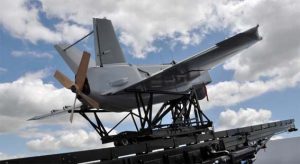
Military transmissions suffer from the same interference issues as commercial transmissions do and call for similar mitigation remedies, writes Martin Coleman, executive director, Satellite Interference Reduction Group (IRG).
In the April issue of SatellitePro Middle East, we discussed the need for Carrier ID in time for the Olympics later this year. We have put a lot of effort into bringing the broadcast community on board with tackling satellite interference. However, there are many other users of satellites and that is part of the problem. The military is no exception and is the one area where fixing the problem of satellite interference is the most crucial, as it can, and often does, jeopardise vital operations.
I am glad to report that at both the Stratcom event (December 2011) and the recent satellite show in Washington DC, we have had encouraging support from our military colleagues and, I believe, we are of like mind when it comes to mitigation of satellite interference. To this end, we are continuing to include all aspects of the communications spectrum and using training and certification, type approvals and carrier ID as the principle initiatives to help move forward on this critical subject.
Impact of interference on the military
The effect on the military is exactly the same as that of commercial transmissions. There is no difference; it means degradation or a complete loss of service!
Of course, in the middle of a crucial operation this could be critical, affecting an operation, but also, potentially, the lives of those carrying out that operation. It is therefore critical in a military environment to reduce satellite interference and its effects.

Factors causing interference
Satellite interference is caused by a number of factors and not due to deliberate signal jamming, which, originally, was the inferred cause for many years until statistics proved otherwise. In the main it is us, the operator or the equipment itself.
In the military arena, auto-deploy systems are used prolifically and for good reason, as they reduce manpower, costs, and the ability to be left unmanned. The problem with unmanned systems, however, is that deployment rules are at best basic and in most cases, the systems will be deployed or withdrawn from deployment regardless of the presence of certain essential parameters to reduce interference.
These systems are crucial for the military and it would simply not be practical to get rid of them, and that is certainly not what I’m suggesting. There are a number of well thought out, intelligent, systems available from very few companies which ensure proper operation at all times. If we could only ensure that such “intelligence” is used, I am confident that alone would significantly reduce occurrences of interference.
Following a lively discussion at our recent sIRG conference at the end of last year, we have set up a working group to look more deeply into improving auto-deploy software systems, that endeavor to ensure interference-free operation. The group is just in its initial stages and is tackling the issue of satellite identification. Our hope is to work towards some key resolutions and ideas that we can help incorporate into GVF’s Product Quality Assurance Framework. The process has already begun with auto-deploy manufacturers making necessary design improvements as standard. We welcome anyone who thinks they may have something to add to this group.
A common misconception is that interference is something we simply have to put up with
Solving interference
A common misconception is that interference is something we simply have to put up with. There are, however, a number of ways to reduce interference and I would like to think that we will eventually be able to eradicate it altogether. The only way we can achieve this is by working together. We have already done an enormous amount of work with satellite operators, broadcasters and equipment manufacturers across the globe, establishing a number of initiatives and good working practices to tackle this growing problem. I would like to continue this proactive phase with the military as I believe that if we roll-out these same initiatives, we would see a significant reduction in instances of interference within both the military and commercial arenas as these often overlap.
Initiatives from the military
That said, some in the military have done much in trying to prevent interference. For example, the US Navy funded an IRG-GVF with the WiMAX-VSAT C-band test and proved the catastrophic affects of using WiMAX at C-band. Also, the DoD unit that sets up communications for the US president have obtained GVF certification and now include an examiner on their staff. And there are many more…
In order to reduce the number of instances of military-based Satcom interference, it is in fact as simple as rolling out the same initiatives we have been pushing hard elsewhere, including Carrier Identification (ID), which essentially means that the carrier can be quickly identified, so when interference occurs, the satellite operator can identify instantly how to resolve the problem.
Currently Carrier ID is only being applied to the commercial broadcast scenario. I believe, by utilising very simple ID codes, military transmissions should be included
Extending application of Carrier ID
Currently Carrier ID is only being applied to the commercial broadcast scenario. I believe, by utilising very simple ID codes, military transmissions should be included. After all we do not want the situation where all broadcast carriers in the future have ID and, therefore, by simple analysis, anything else not having an ID must be military?
It is in the interests of everyone in the industry to integrate Carrier ID however, as it means that if interference on your feed is found, the operator can quickly and efficiently solve the problem. There are already a number of equipment manufacturers developing and integrating Carrier ID and we are already at the technical committee stage of the integrating Carrier ID in to DVB.
Training and certification initiatives
Other initiatives, such as the Global VSAT Forum’s (GVF) system of training and certification for VSAT installers, are already under way. The GVF VSAT Installation and Maintenance Training Course was created to serve as the global industry standard for installers of bi-directional satellite earth stations. It was established by a consensus of expert volunteers serving in the GVF Education and Training Working Group.
The global aim is to only use installers who have undergone formal training and certification to work in all areas of satellite transmission
GVF is now looking to integrate these methods for SNG and FlyAway operations. The global aim is to only use installers who have undergone formal training and certification to work in all areas of satellite transmission.
I know that many manufacturers follow a great deal of due diligence when it comes to ensuring their products include high quality and outstanding specifications needed for satellite transmission equipment.
Interference Reduction Group (IRG) has been working with GVF, WBU-ISOG and the RFI-EUI to help define minimum equipment requirements and introduce a cost effective system of type approvals. As with training, I would like to see a situation whereby equipment not meeting those requirements will simply not get purchased throughout every area of our satellite industry.
Military and private sector collaboration
The problem of interference is not going to be solved overnight and it is not going to be solved by any one individual or group of individuals. We place a lot of emphasis on working together with the other groups, from within the entire industry, from equipment manufacturers, through to satellite operators, uplinkers to end users; whether that is broadcasters, military users or from the maritime industry, all have an important part to play.
These initiatives are in place to help tackle interference, and we are working to encourage people experiencing interference to share the problem and resolution, or the lack of resolution, ask for guidance and help from our members and associates.
Working together in this way, we can solve interference!














Add Comment